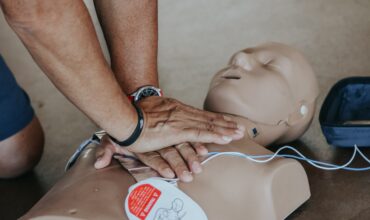- Your cart is empty
- Continue Shopping


In rural America, where vast open spaces stretch for miles and communities are scattered, every second counts during a medical emergency. Unfortunately, long response times for Emergency Medical Services (EMS) in rural areas have been a persistent concern. However, a beacon of hope has emerged in the form of Rural Automated External Defibrillators (AEDs). These life-saving devices are transforming emergency response in remote regions, providing a crucial link in the chain of survival. In this article, we will delve into the world of Rural AEDs, exploring their significance, deployment, and the impact they have on rural communities.
Rural areas offer picturesque landscapes and peaceful living, but they also present unique challenges when it comes to emergency medical care. One of the most pressing issues is the extended time it takes for EMS personnel to reach remote locations.
Imagine you’re in a small town nestled amidst rolling hills, and a neighbor suddenly collapses due to a cardiac arrest. You call 911, and you’re told that help is on the way, but it will take at least 30 minutes for the ambulance to arrive. In such a situation, every passing second feels like an eternity, and swift action is imperative to increase the chances of survival.
This is where Rural AEDs come into play. An Automated External Defibrillator (AED) is a portable device that can deliver an electric shock to the heart to help restore its normal rhythm during sudden cardiac arrest. Rural AEDs are strategically placed in communities, ensuring that they are readily accessible during emergencies.
Consider a scenario where a rural school is equipped with a Rural AED. If a student or staff member experiences cardiac arrest, immediate access to this life-saving device can make all the difference. Bystanders can quickly respond, apply the AED, and initiate the necessary steps while waiting for professional medical help to arrive.
Why is rapid defibrillation so critical during cardiac arrest? The answer lies in the “golden window” of opportunity. When someone’s heart goes into a life-threatening arrhythmia, each minute that passes without defibrillation reduces their chance of survival by 7% to 10%. In rural areas where response times can be considerably longer, having AEDs readily available becomes paramount.
Let’s put it into perspective. In a rural community without a nearby AED, a person experiencing cardiac arrest might have to wait 20, 30, or even 40 minutes for professional help to arrive. During this time, their odds of survival diminish significantly. However, if a Rural AED is within reach, bystanders can administer life-saving shocks within minutes, greatly increasing the chances of a positive outcome.
To effectively address the issue of long response times in rural areas, strategic deployment of Rural AEDs is essential. This involves identifying high-risk locations and ensuring that AEDs are placed in areas with the greatest potential for use.
For instance, community centers, schools, recreational facilities, and fire stations are prime candidates for AED installation. These locations tend to have higher foot traffic, making it more likely that an AED will be available when needed. Additionally, these sites often serve as focal points for rural communities, making them easily accessible in case of an emergency.
One of the most significant advantages of Rural AEDs is that they empower the community to take proactive measures in emergency situations. Training programs are often conducted to educate residents on how to use AEDs effectively. This training not only ensures that people are comfortable using the devices but also fosters a sense of collective responsibility within the community.
Imagine a close-knit farming community where everyone knows their neighbors. In such a community, AED training can turn ordinary citizens into potential life-savers. They become the first responders, bridging the gap until professional EMS personnel arrive. This not only saves precious time but also strengthens the community’s resilience in the face of medical emergencies.
Modern technology plays a pivotal role in the effectiveness of Rural AEDs. Many of these devices are equipped with features that guide users through the resuscitation process. Clear voice instructions and visual prompts make it easier for even untrained individuals to operate the AED with confidence.
Moreover, some Rural AEDs are integrated with remote monitoring systems. This allows EMS providers to access real-time data, such as the device’s status and the patient’s condition, even before they arrive on the scene. This level of connectivity can be a game-changer in rural areas, where information can mean the difference between life and death. Philip AED batteries, for example, have a long lifespan that reduces maintenance costs for devices.
While the benefits of Rural AEDs are undeniable, implementing and maintaining these programs in rural communities require funding and support. Thankfully, various organizations and initiatives have recognized the importance of AEDs in remote areas and are actively working to make them more accessible.
Government agencies, including the United States Department of Agriculture (USDA), often provide grants and resources to support rural healthcare initiatives. For instance, individuals in Texas looking to purchase homes in rural areas can explore USDA home loans in Texas as a potential source of financial support for funding a home AED programs.
To truly appreciate the impact of Rural AEDs, let’s delve into a few real-life success stories that highlight their importance:
Maria, a resident of a small rural town, was enjoying a quiet evening at home when her husband suddenly collapsed. She immediately called 911, but the nearest ambulance was 25 minutes away. Panic set in, but Maria remembered that her community center had recently acquired a Rural AED.
With trembling hands, Maria rushed to the community center, grabbed the AED, and returned to her husband’s side. The device provided clear and concise instructions, allowing her to administer the necessary shocks. By the time the ambulance arrived, Maria’s husband was stable and on the path to recovery.
In another rural community, a high school football game took a terrifying turn when one of the young athletes collapsed on the field. The nearest hospital was over 30 minutes away, and the situation seemed dire. However, the school had a Rural AED on-site.
The coach and athletic trainer quickly retrieved the AED and initiated resuscitation efforts. Thanks to their prompt response and the availability of the AED, the athlete’s life was saved. The incident served as a stark reminder of the importance of having these devices readily accessible in rural schools and sports facilities.
Living on a remote ranch can be idyllic, but it also means being far from immediate medical assistance. One day, a rancher suffered a heart attack while working alone in the fields. He had the foresight to keep a Rural AED in his truck.
As the minutes ticked away, the rancher’s life depended on his quick thinking and the AED he had on hand. He managed to reach the device and administer the necessary shocks, ultimately saving his own life. This story illustrates the life-saving potential of Rural AEDs for those who reside in isolated areas.
Implementation Guide